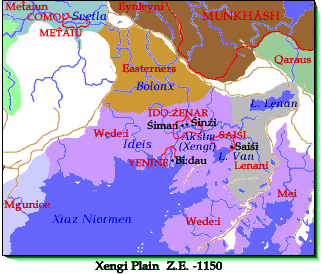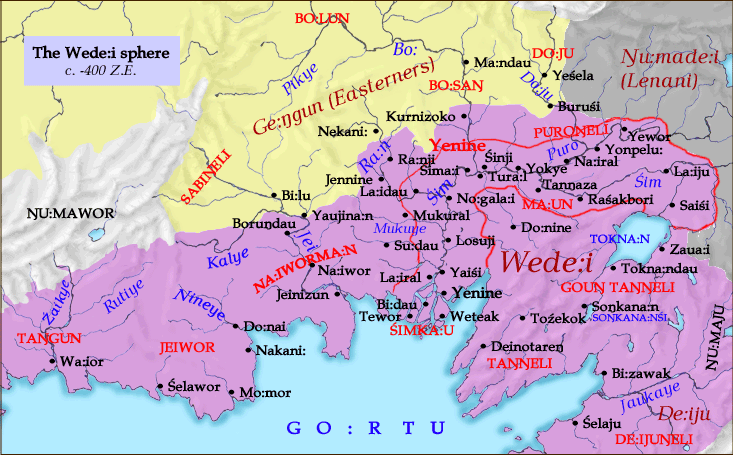Page 1 of 2
The Wede:i family
Posted: Fri Jan 02, 2004 12:41 am
by zompist
I am personally tickled by the contrast between

and

The language itself has been improved almost as much.

Posted: Fri Jan 02, 2004 2:30 am
by doctrellor
It looks good Zomp...ya did a good job
Posted: Fri Jan 02, 2004 6:23 am
by pharazon
Ah, more Wedei! Cuolese, Jeori, sound changes, even Unicode... *salivates*. Excellent indeed.
Posted: Fri Jan 02, 2004 11:05 am
by Ghost
*drools*
This'll take me a while to read through - I've never read the previous wede:i grammar, but anything coming from Mark rosenfelder has got to be good, ne?
EDIT: and you put Jeerio up! Even better! Oh, and what does 'inexorable' mean?

Ghost


Posted: Fri Jan 02, 2004 1:15 pm
by Warmaster
Nicely done. i was surprised that you brought jeori "back" into existance. i thought it was long forgotten, but its nice to see a ressurection taking place. however, i never did managed to compitently get my head around wede:i, perhaps i'd get it this time. and the new map looks amazing, its good to see some deatail is begining to shift to the south (i want more skouras though *hint*)
And jeerio, thats just soo twee. those pictures make it seem so sweet it is great. the story is really fun as well. i wish i could have wrote like that when i was 11.
Great job there, niice way to opent the new year

The Wede:i family
Posted: Fri Jan 02, 2004 4:06 pm
by Gareth
Great stuff, I particularly like how odd the interlinear translations sound. A couple of questions about Wede:i:
How do you prounounce "j"?
There are a few medial clusters like kz' and kg. Are they pronounced as written or is there assimilation to gz' and gg?
Re: The Wede:i family
Posted: Fri Jan 02, 2004 8:19 pm
by zompist
Gareth wrote:A couple of questions about Wede:i:
How do you prounounce "j"?
There are a few medial clusters like kz' and kg. Are they pronounced as written or is there assimilation to gz' and gg?
1. Uncertain, actually. From the modern languages we would reconstruct /dZ/ (like English j), though the exact manner of articulation is debatable. Axunashin <b>j</b> however seems to have been a fricative /J/, the voiced version of /?/, and this may be influenced by Wede:i.
2. In the east, these eventually assimilated to gz / gg, but in Jeori it assimilated the other way, to ks / kk.
Posted: Sat Jan 03, 2004 12:03 am
by Glenn
...Incidentally, Mark, deeply impressed though I am by your updating of Wedei and its descendants

, I have to note that your beautiful map almost entirely obscures the top portion of the text (on my screen, anyway).
p@,
Glenn
Posted: Sat Jan 03, 2004 1:12 am
by zompist
Glenn Kempf wrote:...Incidentally, Mark, deeply impressed though I am by your updating of Wedei and its descendants

, I have to note that your beautiful map almost entirely obscures the top portion of the text (on my screen, anyway).
I'm not quite sure what you mean. It's just 733 pixels wide; surely you don't have some sort of archaic retrocomputing device that can't handle that? What operating system and browser are you using? Mac IE can handle even a browser window narrower than the map (the text just appears beneath it).
Posted: Sat Jan 03, 2004 10:30 am
by Whimemsz
*drools* Yes! Bwahahahahahaha....gimme!
Err...yes.
One question. How is Wede:i <r> pronounced exactly?
Posted: Sat Jan 03, 2004 10:59 am
by insumaro
It did that to me, too, Glenn. My problem was that I had to change my Screen Area from 800 by 600 pixels to 1024 by768 pixles.
(To do this in Windows, just right click on the desktop and click properties and then click on the Settings tab...then use the little slide bar to adjust the screen size)
And a question: Zomp, aren't those letters such as ng and ? with tilde renderable in Unicode?
Posted: Sat Jan 03, 2004 4:30 pm
by Glenn
Pentekonter wrote:It did that to me, too, Glenn. My problem was that I had to change my Screen Area from 800 by 600 pixels to 1024 by768 pixles.
(To do this in Windows, just right click on the desktop and click properties and then click on the Settings tab...then use the little slide bar to adjust the screen size)
It worked; thanks! (I'll change it back, however, since the text is now a bit small to read, especially for my parents.)
p@,
Glenn
Posted: Sat Jan 03, 2004 4:55 pm
by zompist
Pentekonter wrote:It did that to me, too, Glenn. My problem was that I had to change my Screen Area from 800 by 600 pixels to 1024 by768 pixles.
800x600?! That's the dark (or more precisely the cramped) ages, man!
My monitor at home is 1680x1050, but I'm a freak for big screens. For writing or artwork, the more you can see the better.
And a question: Zomp, aren't those letters such as ng and ? with tilde renderable in Unicode?
Yes, if you have a Unicode font that contains them. The problem is that Unicode on IE, the most popular browser, does not degrade nicely. It doesn't replace characters it can't render with something recognizable; it displays a box or a question mark.
Posted: Sat Jan 03, 2004 7:41 pm
by con quesa
The page looks very nice. However, everything after the "Numbers" sectoin is bolded. Forget to close a bold tag, Zomp?
Posted: Sat Jan 03, 2004 11:13 pm
by zompist
con quesa wrote:The page looks very nice. However, everything after the "Numbers" sectoin is bolded. Forget to close a bold tag, Zomp?
Looked fine for me-- what browser/OS are you using? I did just make a minor change there; see if that fixes it for you.
Posted: Sun Jan 04, 2004 1:26 am
by con quesa
I use Opera version 7.23, but the text looks normal again.
Posted: Sun Jan 04, 2004 4:24 pm
by Rory
Last night I read over the grammar, and wrote my li'l notes and questions for posting today. These only refer to Wedēi.
Transcription! A:rgh! Why not use acutes or macrons?
Some grammatic errors in the document: referring to Wedēi in both past and present tenses, and a few "is"s where there should have been "are"s.
Does this "fist & fingers" number system mean that when Xengi peasants sign numbers to each other meaning "one more" than to we are used to (i.e. they hold up 2 fingers for 3)?
What differentiates <ii> from <i:>? Is the former /i?i/ whereas the latter /i:/?
I am a bit disappointed at lack of full orthographical information, but it doesn't bother me too much.
Posted: Sun Jan 04, 2004 8:39 pm
by insumaro
I'd have to say that I agree with Rory on the colons. They just aren't too ?sthetically pleasing. Of course, I don't particularly like macrons, either.
Wede:i Wedeei Wed?i Wed?i Wed?i
Hmmmm
::remembers that it's not his conlang::
I really like the daughter languages. They do a good job capturing the Wede:i flavor while retaining their own neat perks. (Nasalization, ? and ?, tones, muahahah!)
Posted: Sun Jan 04, 2004 9:34 pm
by Glenn
I would like to cast my vote for representing the long vowels with macrons, as in Cuezi; however, I understand if there are font and/or browser restrictions that prevent this.
Overall, neat stuff!

p@,
Glenn
Posted: Sun Jan 04, 2004 10:22 pm
by Space Dracula
con quesa wrote:
I use Opera version 7.23, but the text looks normal again.
Whoa, me too! Well, with a few customizations.
Posted: Sun Jan 04, 2004 10:22 pm
by Glenn
Rory wrote:Does this "fist & fingers" number system mean that when Xengi peasants sign numbers to each other meaning "one more" than to we are used to (i.e. they hold up 2 fingers for 3)?
I believe that this is indeed the case; I've been thinking about similar issues for my Kiarloni people, who use a duodecimal (base 12) number system.
p@,
Glenn
Posted: Mon Jan 05, 2004 1:49 am
by zompist
Rory wrote:Transcription! A:rgh! Why not use acutes or macrons?
Sorry, colons are the longstanding practice (8 years) of Wede:iologists.
I purposely use different transcription systems, in imitation of terrestrial linguistics.
I'll look for the errors you mention.
Does this "fist & fingers" number system mean that when Xengi peasants sign numbers to each other meaning "one more" than to we are used to (i.e. they hold up 2 fingers for 3)?
Yes indeed. If you venture into a Xurnese bar and hold up one finger, you'll get two beers.
What differentiates <ii> from <i:>? Is the former /i?i/ whereas the latter /i:/?
Phonetically, nothing at all. Where you see
ii, there's a morpheme boundary in between; e.g.
liingokze =
li + ing + ok + ze. A long vowel (as in
Bi:dau) is always part of a single morpheme.
I am a bit disappointed at lack of full orthographical information, but it doesn't bother me too much.
Do you mean, full details on the logographic writing system? Well, someday I'd like to provide that-- not many people have created a whole one, I think. The full system needs 1095 glyphs, of which I've worked out about 135. (I worked out those needed for all the syllables of Axunashin.)
Posted: Mon Jan 05, 2004 8:18 am
by zmeiat_joro
Actually I find colons look better better than diactrics. The only thing that botherred me with them is on the map, the inscription "G O : R T U", I think "G O: R T U" would look better.
Posted: Mon Jan 05, 2004 2:09 pm
by Neon Fox
Ghost wrote:EDIT: and you put Jeerio up! Even better! Oh, and what does 'inexorable' mean? :oops:
"Unable to be stopped"
Try though he might, he could not resist the inexorable rush of floodwater.
--Neon Fox
Posted: Mon Jan 05, 2004 3:20 pm
by So Haleza Grise
There appear to be some We:dei cities in Easterner territory; are these trading outposts or something?
Ooh, and while I'm at it, a few more questions:
Do you envision giving Cuolese and Jeori each their own seperate pages in the future?
Jeori is now a dead language, not spoken as a native tongue anywhere, is this correct? Or are there still isolated pockets where it exists?
How widespread is the knowledge of modern Jeori (I suppose I'm really asking a question about the Tasuc Tei education system)? Is it a requirement for any kind of professional life, or can most people, outside of maybe state officials and bureaucrats, get by without it?
On a morphological/syntatic note, it was perhaps surprising to see that both We:dei descendent branches maintained both their accusative and dative cases under pressure from Xurnese, which, as I understand it, has a pragmatics-based case system. Does the "free word order" rule from We:dei still apply? Is topicalisation used as a word order feature?







, I have to note that your beautiful map almost entirely obscures the top portion of the text (on my screen, anyway).